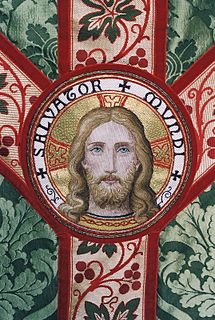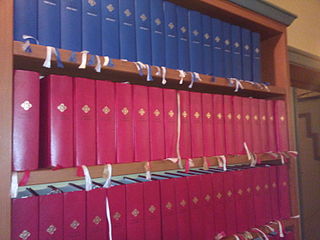Related Research Articles
The Apostles' Creed, sometimes titled the Apostolic Creed or the Symbol of the Apostles is a Christian creed or "symbol of faith".

Book of Common Prayer (BCP) is the short title of a number of related prayer books used in the Anglican Communion, as well as by other Christian churches historically related to Anglicanism. The original book, published in 1549 in the reign of Edward VI, was a product of the English Reformation following the break with Rome. The work of 1549 was the first prayer book to include the complete forms of service for daily and Sunday worship in English. It contained Morning Prayer, Evening Prayer, the Litany, and Holy Communion and also the occasional services in full: the orders for Baptism, Confirmation, Marriage, "prayers to be said with the sick", and a funeral service. It also set out in full the "propers" : the introits, collects, and epistle and gospel readings for the Sunday service of Holy Communion. Old Testament and New Testament readings for daily prayer were specified in tabular format as were the Psalms; and canticles, mostly biblical, that were provided to be said or sung between the readings.

Mass is the main Eucharistic liturgical service in many forms of Western Christianity. The term Mass is commonly used in the Catholic Church, and in the Western Rite Orthodox, and Old Catholic churches. The term is used in some Lutheran churches, as well as in some Anglican churches. The term is also used, on rare occasion, by other Protestant churches, such as in Methodism.

Advent is a season of the liturgical year observed in most Christian denominations as a time of expectant waiting and preparation for both the celebration of the Nativity of Christ at Christmas and the return of Christ at the Second Coming. Advent is the beginning of the liturgical year in Western Christianity, and is part of the wider Christmas and holiday season.

Ordinary Time is the part of the liturgical year in the liturgy of the Roman Rite, as revised in 1969, which falls outside the two great seasons of Christmastide and Eastertide, or their respective preparatory seasons of Advent and Lent. Ordinary Time thus includes the days between Christmastide and Lent, and between Eastertide and Advent.The liturgical color assigned to Ordinary Time is green. The last Sunday of Ordinary Time is the Solemnity of Christ the King.

The Anglican Use is an officially approved form of liturgy used by former members of the Anglican Communion who joined the Catholic Church while wishing to maintain "aspects of the Anglican patrimony that are of particular value".

Common Worship is the name given to the series of services authorised by the General Synod of the Church of England and launched on the first Sunday of Advent in 2000. It represents the most recent stage of development of the Liturgical Movement within the Church and is the successor to the Alternative Service Book (ASB) of 1980. Like the ASB, it is an alternative to the Book of Common Prayer (BCP) of 1662, which remains officially the normative liturgy of the Church of England.

Christian liturgy is a pattern for worship used by a Christian congregation or denomination on a regular basis. The term liturgy comes from Greek and means "public work".

The Lutheran Book of Worship (LBW) is a worship book and hymnal used by several Lutheran denominations in North America. Additional hymns and service music are contained in the companions, Hymnal Supplement 1991 and With One Voice (WOV). The LBW is sometimes called the "green book", as opposed to With One Voice, which is bound in blue; or Service Book and Hymnal, which is bound in red; or The Lutheran Hymnal, which is also bound in red, with a simple gold cross.
The Liturgical Movement began as a 19th-century movement of scholarship for the reform of worship within the Roman Catholic Church. It has developed over the last century and a half and has affected many other Christian churches, including the Church of England and other churches of the Anglican Communion, among other Protestant churches. A similar reform in the Church of England and Anglican Communion, known as the Oxford Movement, began to change theology and liturgy in the United Kingdom and United States in the mid-nineteenth century. The Liturgical Movement has been one of the major influences on the process of the Ecumenical Movement, in favor of reversing the divisions which began at the Reformation.

Evangelical Lutheran Worship (ELW) is the current primary liturgical and worship guidebook and hymnal for use in the Evangelical Lutheran Church in America and the Evangelical Lutheran Church in Canada, replacing its predecessor, the Lutheran Book of Worship (LBW) of 1978, and its supplements, Hymnal Supplement 1991 and With One Voice (WOV).

The Lutheran liturgical calendar is a listing which details the primary annual festivals and events that are celebrated liturgically by various Lutheran churches. The calendars of the Evangelical Lutheran Church in America (ELCA) and the Evangelical Lutheran Church in Canada (ELCIC) are from the 1978 Lutheran Book of Worship and the calendar of Lutheran Church–Missouri Synod (LCMS) and the Lutheran Church - Canada use the Lutheran Book of Worship and the 1982 Lutheran Worship. Elements unique to the ELCA have been updated from the Lutheran Book of Worship to reflect changes resulting from the publication of Evangelical Lutheran Worship in 2006. The elements of the calendar unique to the LCMS have also been updated from Lutheran Worship and the Lutheran Book of Worship to reflect the 2006 publication of the Lutheran Service Book.
The liturgical reforms of Pope Pius XII continued a process initiated by Pope Pius X, who began the process of encouraging the faithful to a meaningful participation in the liturgy. Pope Pius XII redefined liturgy in light of his previous encyclical Mystici corporis and reformed several liturgical practices in light of this teaching. The liturgical teaching of Pius XII is contained especially in his encyclical Mediator Dei of 1947. Although Pius XII felt compelled to reprove the desire for novelty among certain leaders of the Liturgical Movement, the liturgical reforms undertaken later in his pontificate were in fact relatively broad in their scope.

A liturgical book, or service book, is a book published by the authority of a church body that contains the text and directions for the liturgy of its official religious services.

Lutheran Worship (LW) is one of the official hymnals of The Lutheran Church–Missouri Synod (LCMS). Published in 1982 by Concordia Publishing House in St. Louis, Missouri, it is the denomination's third English-language hymnal and was intended to replace The Lutheran Hymnal (TLH). Additional hymns and service music are contained in the companion, Hymnal Supplement 98.

Divine Worship: The Missal (DW:TM) is the liturgical book containing the instructions and texts for the celebration of Mass by the former Anglicans within the Catholic Church in the three personal ordinariates of Great Britain, United States and Canada, and Australia. The rite contained in this missal is the Anglican Use, a variant of the Roman Rite eucharistic liturgy. It was approved for use beginning on the first Sunday of Advent, November 29, 2015.
Norsk Salmebok, published in 1985, was the official hymnal of the Church of Norway from 1985 to 2013.

Norsk salmebok 2013: for kirke og hjem is the hymnal of the Church of Norway. It is published by Eide Forlag and was adopted for use on the first Sunday of Advent in 2013.
Protestant liturgy is a pattern for worship used by a Protestant congregation or denomination on a regular basis. The term liturgy comes from Greek and means "public work". Liturgy is especially important in the Historical Protestant churches, both mainline and evangelical, while Baptist, Pentecostal, and nondenominational churches tend to be very flexible and in some cases have no liturgy at all. It often but not exclusively occurs on Sunday.
References
- 1 2 Nå forsvinner høymessen. 2011. Dagbladet (November 20, 2011).
- ↑ Alt klart for ny salmebok. 2012. Kirkebladet for Harstad 13(2): 8.
- ↑ "Jul med ny salmebok. 2013. Kirkeaktuelt (November 22, 2013)". Archived from the original on July 12, 2014. Retrieved September 9, 2016.